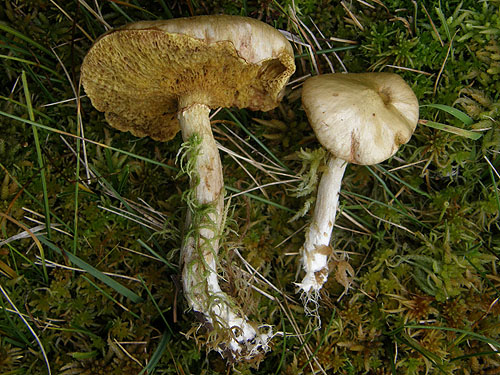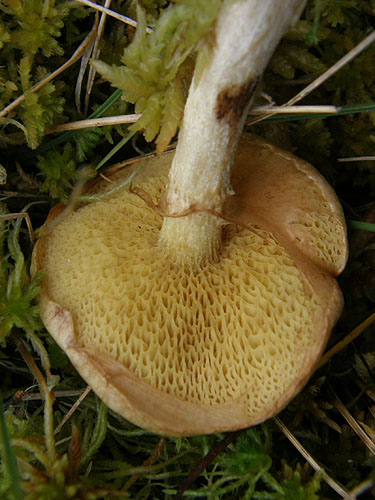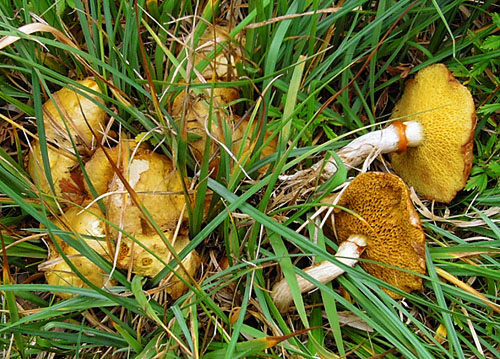Suillus Adans.
A number of species are known in Europe. Fruitbody boletoid without or with partial veil, and then leaving a ring on the stipe. Cap in most species more or less viscid. Stipe solid.
Suillus flavidus (Fr. : Fr.) J. Presl
Description
Fruitbody with partial veil, leaving more or less visible ring on the stipe. Cap up to 5 cm, at first hemispherical then expanding to convex, at first ivory, then yellowish, sometimes spotted olivaceous or entirely with somewhat olive tint, viscid. Stipe, cylindrical, more or less dirty white, whitish or pale yellowish, with more or less distinct viscid ring, , basal mycelium pale whitish. Flesh pale yellow to whitish. Tubes pale yellow to olivaceous yellow. Pores large, angular, pale yellow to olivaceous yellow. Smell not distinctive. Taste not distinctive. Spores 7.5–11 × 3–4 μm.
Habitat. More or less boreal or alpine species, restricted to wet habitats (often in Sphagnum bogs) with pines, mycorrhizal with two-needled pines (Pinus sylvestris, P. mugo).
Distribution. In Europe rare, restricted by its habitat.
Photographs

Well developed fruitbodies of Suillus flavidus. (photo B. Assyov)

Suillus flavidus. Note the disrupted partial veil, leaving ring on the stipe and the large angular pores. (photo B. Assyov)

A rich collection of fruitbodies of Suillus flavidus. The gelatinous ring is very well seen. (photo G. Konstantinidis)
Important literature
Alessio, C.L. 1985. Boletus Dill. ex L. (sensu lato). – In: Fungi Europaei. Vol. 2. Pp. 1–705. Libreria editrice Biella Giovanna, Saronno.
Breitenbach J. & Kränzlin F. 1991. Pilze der Schweiz. Bd. 3(1). Röhrlinge und Blätterpilze. Verlag Mykologia, Luzern.
Engel, H., Dermek, A., Klofac, W., Ludwig, E. & Brückner, T. 1996. Schmier – und Filzröhrlinge s. l. in Europa. Die Gattungen Boletellus, Boletinus, Phylloporus, Suillus, Xerocomus. Verlag Heinz Engel, Weidhausen b. Coburg.
Estadès, A. & Lannoy, G. 2004. Les bolets européens. – Bulletin Mycologique et Botanique Dauphiné-Savoie 44(3): 3–79.
Galli, R. 1998. I Boleti. Atlante pratico-monographico per la determinazione dei boleti. Edinatura, Milano.
Hansen, L. & Knudsen, H. 1992. Nordic Macromycetes. Vol. 2. Polyporales, Boletales, Agaricales, Russulales. Nordsvamp, Copenhagen.
Knudsen, H. & Vesterholt, J. [eds.]. 2008. Funga Nordica. Nordsvamp, Kopenhagen.
Lannoy, G. & Estadès, A. 2001. Les Bolets. Flore mycologique d’Europe. Documents Mycologiques Mémoire Hors série no. 6. Pp. 1–163. Association d’Écologie et de Mycologie, Lille.
Muñoz, J.A. 2005. Boletus s. l. – In: Fungi Europaei. Vol. 1. Pp. 1–951. Edizioni Candusso, Alassio.
Pilát, A. & Dermek, A. 1974. Hríbovité huby. Československé hríbovité a sliziakovité huby (Boletaceae – Gomphidiaceae). Veda, Bratislava.
Šutara, J., Mikšík, M. & Janda, V. 2009. Hřibovité houby. Čeled’ Boletaceae a rody Gyrodon, Gyroporus, Boletinus a Suillus. Academia, Praha.